Part Three (English): How the COVID-19 pandemic interrupted college plans for Latino students in Arizona
Daniel Gonzalez reported this story while participating in the USC Annenberg Center for Health Journalism’s 2021 Data Fellowship.
Other stories by Daniel Gonzalez include:
How COVID-19 pandemic magnified challenges for Arizona students not proficient in English
Enrollment dropped. Absences soared. How one Arizona school is fighting pandemic learning loss
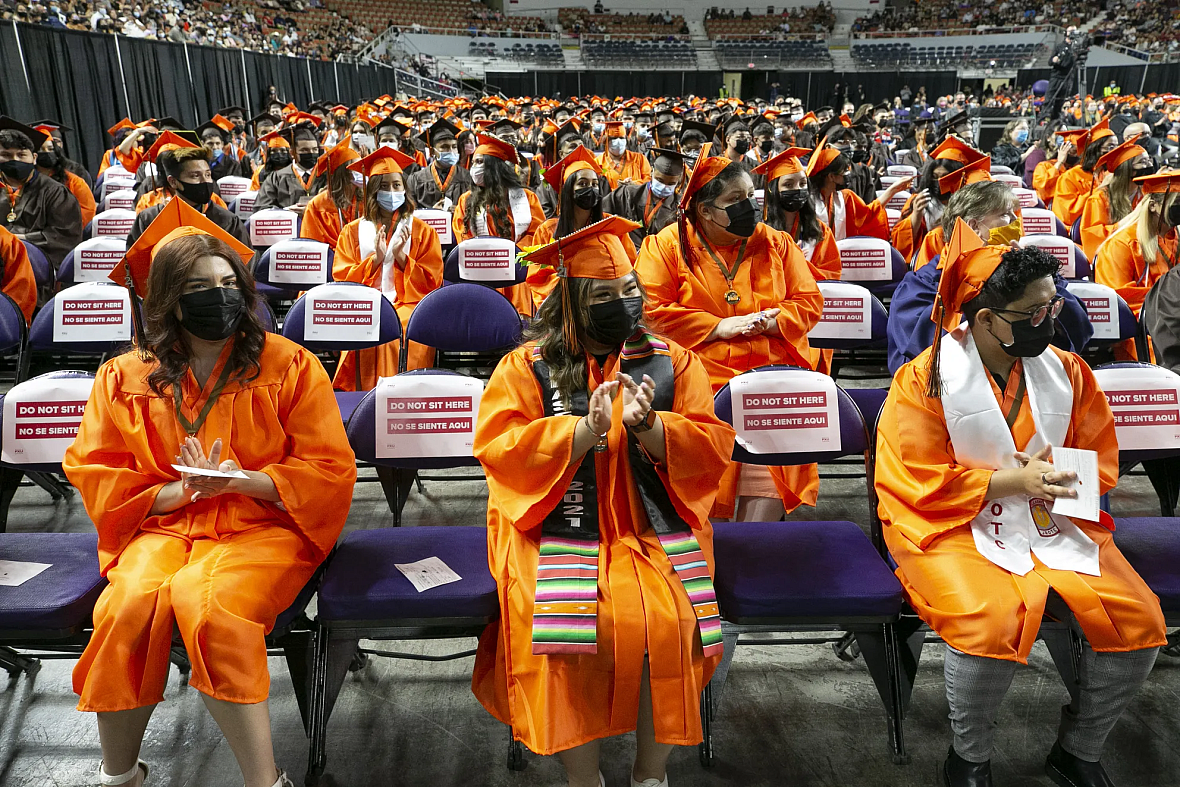
AZCentral
To read this story in Spanish, click here.
Cesar Soberanes was a high school senior planning what to do after graduation. It was spring 2020, just as the COVID-19 pandemic was gaining steam.
The son of a working-class, Mexican immigrant mother, his goal was to become the first in his family to attend college.
He had his sights set on Arizona State University after graduating from ASU Preparatory Academy, a public charter school in downtown Phoenix affiliated with the university.
He had filled out the application and, after learning he had been accepted, Soberanes enrolled.
Ready to start classes the following fall, he began proudly telling friends and family he was headed to ASU. During his high school graduation ceremony, which required graduates to stay in their cars because of the pandemic, the words "Arizona State University" flashed on a movie screen alongside his name, indicating where Soberanes was headed.
That really made it feel official.
Cesar Soberanes, 19, had planned to attend Arizona State University. However, the pandemic and finances forced him to change his plans. MEGAN MENDOZA/THE REPUBLIC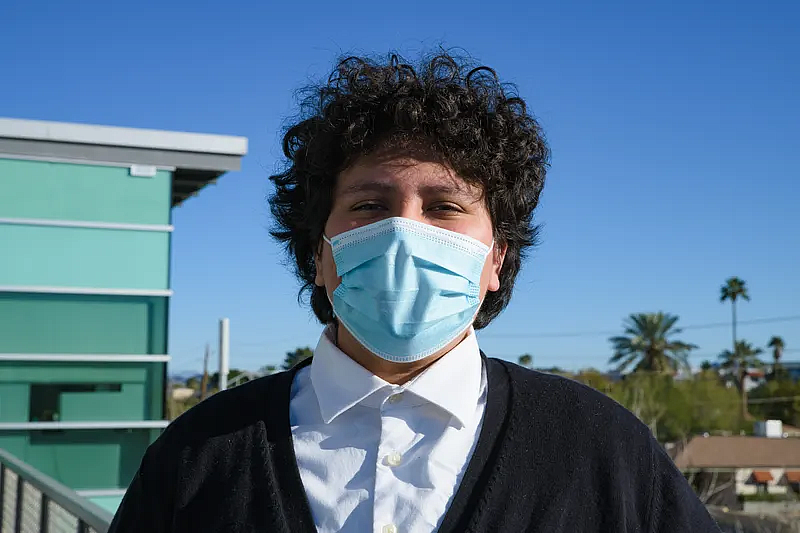
But Soberanes never made it to ASU. In March of that year he lost his minimum-wage job greeting guests at the former Talking Stick Resort Arena in downtown Phoenix. When the pandemic lockdown hit, the arena was forced to temporarily shut down.
Unable to land another job as the pandemic wore on, Soberanes could not justify the financial expense of attending college, especially because he was footing the bill himself.
So just weeks before classes were scheduled to start, Soberanes made the painful decision to withdraw.
Soberanes felt like he had let a lot of people down. Above all, himself.
"For the longest time I had been I announcing that I would go to ASU, like to my whole family, (and) friends," Soberanes said. "I didn't know what to do. I felt like a liar almost."
Soberanes is not alone in his pandemic-related frustration as a young Latino with college ambitions.
The number of Latino students enrolling in college in Arizona had been steadily increasing in recent years, considered key to overall efforts to significantly boost Arizona's college-educated population, which lags behind other states.
An analysis of enrollment data by The Arizona Republic found that the pandemic disrupted the college plans of thousands of Latino students in Arizona, leading to sharp decreases in Latino enrollment at local community colleges and at Northern Arizona University.
Surprisingly, Latino enrollment increased at the University of Arizona and Arizona State University during the pandemic as more students chose to remain in state.
Enrollment of Latino students at Maricopa Community Colleges, which serves metro Phoenix, plummeted by more than 7,000 students from 2019 to 2021, data shows. That amounted to a 17% drop in enrollment over the past two years at the 10 community colleges in the Maricopa County Community College District, the analysis shows.
The sharp decrease in Latino enrollment during the pandemic nearly wiped all the gains in Latino enrollment since 2012 at the Maricopa Community Colleges, the analysis shows.
The sudden drop is particularly concerning because the Maricopa Community Colleges serve the highest number of Latino students pursuing higher education in Arizona. Because of their lower tuition rates, community colleges often serve as a stepping stone for students who later transfer to four-year universities.
The decrease in Latino enrollment is alarming because Arizona already has one of the lowest higher education attainment rates in the nation. College attainment rates are even lower among Latinos. Latinos are the largest demographic group among K-12 students. They are a fast-growing demographic group viewed as essential to the state’s future workforce and economic success.
On a bright note, the number of Latino undergraduates enrolled at all three of the state’s public universities increased 10% during the pandemic, the analysis shows. But the increase was not even across all three universities.
The University of Arizona and Arizona State University, the two largest public universities, experienced significant increases in Latino undergraduate student enrollment over the past two years, 15% and 11% respectively, the data shows.
University administrators attributed the increases to more Latino students deciding to remain in-state or enroll in online courses that allow them learn from home during the pandemic.
At Northern Arizona University, Latino enrollment fell by 5% in 2020 and another 2% in 2021, data shows.
The decreases followed years of steady increases in Latino enrollment at NAU before the pandemic.
Estudiantes caminan en el campus de ASU en el centro de Phoenix durante el primer día de clases presenciales de ASU el 19 de agosto de 2021. David Wallace/The Republic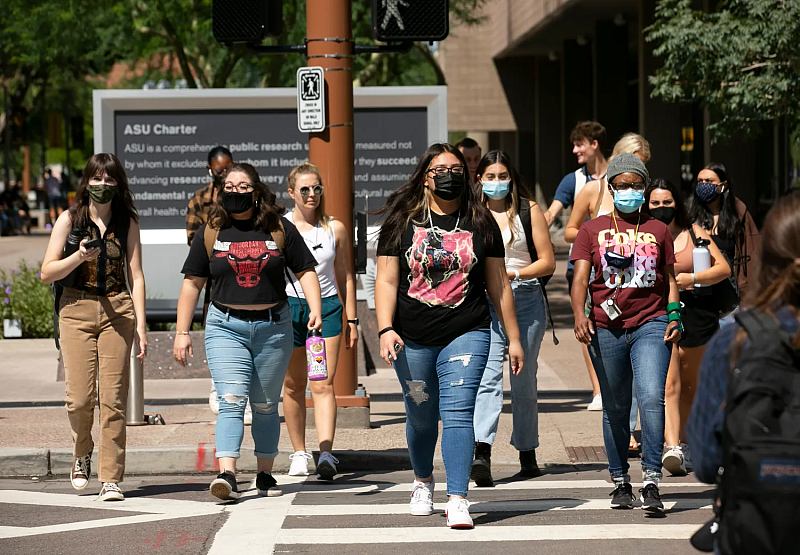
Pandemic disrupted college plans in many ways
Early on, the pandemic disproportionately affected Latinos, who experienced high rates of financial hardships, as well as hospitalizations and deaths, in part because a larger share of Latinos work in jobs that put them at risk of exposure to COVID-19.
"We know that the pandemic, at least the initial stage of the pandemic, hit nonwhite populations much more severely. They were twice as likely to be hospitalized or die as a result of COVID," said Kishia Brock, associate vice chancellor of academic and student affairs at the Maricopa County Community College District. "Most of them because they are in blue-collar jobs and weren't able to work remotely and had to continue to support their families or have lost income altogether during the shutdown."
Cesar Soberanes, 19, un estudiante de arte y ganador de la Beca Helios Adelante, dibuja para una fotografía afuera del Edificio de Artes en Phoenix College en Phoenix, Arizona, el 7 de febrero de 2022. Megan Mendoza/The Republic
As a result, the pandemic disrupted college plans for Latino students in myriad ways, according to interviews with college and university administratoors and experts.
Some Latino students were forced to postpone enrolling, or left college altogether after loss of jobs or income created financial hardships for them and their families, especially those from lower-income backgrounds such as Soberanes, whose mother works as a custodian.
The fear is that many Latino students who postponed enrolling or left college will not return.
Others changed plans, choosing to remain in-state rather than risk the financial and emotional uncertainty of enrolling in a college or university farther from home. Others decided to enroll in online-only courses instead of in-person classes.
Some nonprofit groups in Arizona have launched initiatives to offer financial assistance to students whose college plans were disrupted.
The Helios Educational Foundation and the group College Success Arizona, for example, created the Arizona Post Secondary Student Resiliency Fund. The fund provided financial support to college students who were struggling with unexpected expenses during the first few months of the pandemic, as campuses closed and many students were suddenly forced to return home to learn online.
Helios partnered with Education Forward Arizona to create the Helios Adelante Scholarship Initiative. The program provides $1,000 scholarships to students whose college enrollment plans were derailed by the pandemic.
Estudiantes en el campus de ASU, Tempe, Arizona, el 31 de agosto de 2021. Mark Henle/The Republic
Soberanes received one of the Adelante grants. He used the $1,000 to buy textbooks at Phoenix College, where he began taking classes in fall 2021 after missing his first year at ASU.
Some colleges and universities have directly reached out to students in hopes of getting them to re-enroll.
But the later stages of the pandemic have created new challenges in bringing back students.
Labor shortages generated by the sudden reopening of the economy have boosted wages. Now instead of financial hardships, colleges and universities are competing with higher wages to lure students back to the classroom.
Arizona's college goal depends on more Latinos completing degrees
Arizona has set a goal of having 60% of the state's residents ages of 25-64 complete a 2-year or 4-year degree or hold an active certificate or license by the year 2030.
Arizona ranks 30th among states based on an analysis of college attainment for the population 25 and above with a bachelor's degree or higher, according to 2020 census data.
Arizona's 18 to 24-year-old college-age population is growing. It increased by nearly 6% from 2012 to 2020, according to census data provided by the Arizona Office of Economic Opportunity.
We can't continue to be successful as a state if our Latino population is not growing at the level that it needs to. -Richard Daniel, executive vice president of Education Forward Arizona
But to achieve the "60 by 30" goal, 125,000 more people per year will need to complete a college degree or certificate by 2030. At least half of those new credentials will need to come from people already in the workforce who have some or no college.
The goal will be impossible to achieve without a significant boost in the number of Latinos in Arizona who complete post-secondary education.
About 46% of the state's residents in that age group have met the goal, as of 2020, according to data compiled by Education Forward Arizona and posted on its website. Only about 28% of Latinos in that age group had completed a 2- to 4-year college degree or hold a professional certificate or license, compared with 55% for white students.
"What we need to understand is that if we're going to be successful as a state, the Latino population has to have a higher educated populace than we currently have. We can't continue to be successful as a state if our Latino population is not growing at the level that it needs to," said Richard Daniel, the executive vice president and chief operating officer of Education Forward Arizona, a nonprofit that works to expand college attainment opportunities.
Latino students make up the largest share of Arizona's high school population, 46% compared with 38% for white students.
Yet Latinos enroll in college at lower rates than white students, 40% compared with 53%, 2020 data shows.
Estudiantes caminan junto a la torre del reloj en Mesa Community College. Tom Tingle/The Republic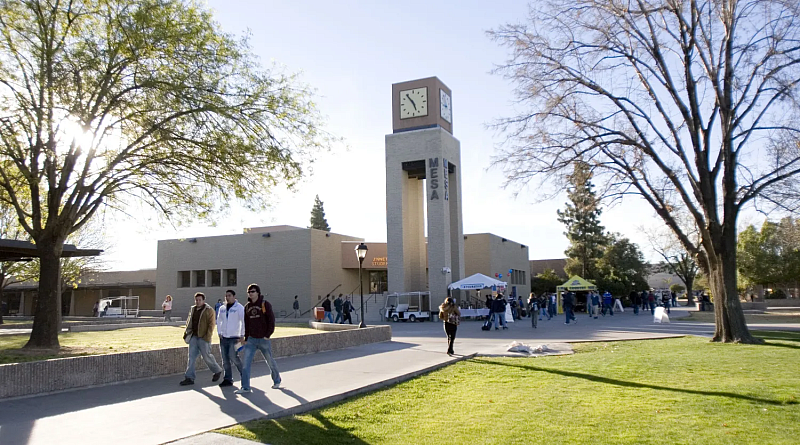
Community colleges saw drop in Latino enrollment
At the Maricopa Community Colleges, administrators are reaching out to students who disenrolled during the pandemic and are taking steps to prevent students from leaving.
"We have to first figure out how to keep our students while we're figuring out how to bring them back," Brock said.
Those efforts include providing support to students who have been struggling financially, such as expanding food pantries at the colleges, said Ray Ostos, the Maricopa County Colleges' director of student affairs.
"We had students that were struggling with food insecurity when the pandemic hit and it just became much worse," Ostos said.
The district has been trying to contact students who left during the pandemic. The district sent text messages or made phone calls this spring to about 4,000 students who had disenrolled during the pandemic and had not enrolled or transferred to another college or university, Brock said.
The goal is "trying to get them reengaged and reconnected with our institution," Brock said.
The class of 2021 graduates from high schools around the Phoenix area, including Mesa, Scottsdale, Glendale, Tempe and Phoenix.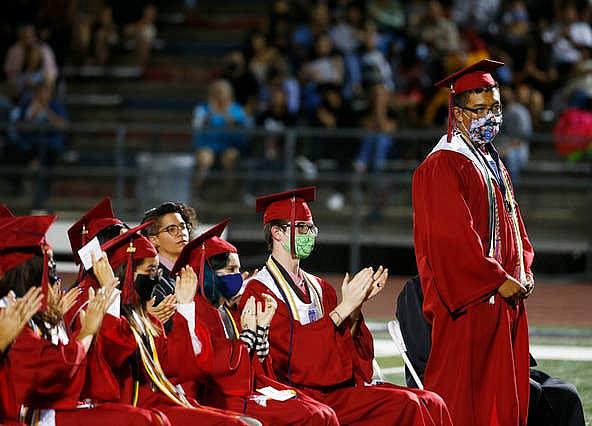
The district plans to use federal money received during the pandemic to invest in a grassroots program. The program to be launched later this year will provide book money to students who refer other students who left during the pandemic and to the students who return, she said.
Latino student enrollment at the Maricopa Community Colleges peaked at 41,706 in 2019. That was a 23% increase from 2012, an analysis of enrollment data shows.
In 2020, Latino student enrollment plummeted 16% from pre-pandemic numbers, and then fell another 2% in 2021. The decreases in Latino enrollment in 2020 and 2021 have nearly wiped out the gains since 2012, the data shows.
The decline in Latino enrollment is part of an even greater decline in overall enrollment at the Maricopa Community Colleges.
Overall enrollment has fallen 30% since 2012, the data shows.
As a result, the share of Latino students enrolled at the Maricopa Community Colleges has grown to 37% of the overall number of students enrolled, up from 26% in 2012, the data shows.
The strong job market, and higher wages, has fueled some of the recent declines in enrollment, Brock said. In the past, students from marginalized communities were more likely to forego college to work. Brock believes the strong job market also is keeping more white students from enrolling.
"Right now, you can get entry level jobs for $15 an hour with no experience," she said.
Ostos agreed. "They're just putting things on hold. They're not actively looking to get back into higher education (because) they're making pretty good money. "
A study of National Student Clearinghouse data showed that most students who disenrolled during the pandemic stopped attending college.
"They didn't go anywhere else," said Lori Lindenberg, director of enterprise analytics and strategy at Maricopa Community Colleges.
Imagen del letrero del campus de la Universidad de Arizona en Tucson. Michael Chow/The Republic
UA saw increase in enrollment during pandemic
At the University of Arizona, Latino enrollment has increased during the pandemic, which may seem surprising given the decreases in Latino enrollment at other schools, especially community colleges.
Administrators believe Latino students from Arizona who initially intended to enroll at colleges or universities out of state chose instead to enroll at the University of Arizona to be closer to home during the pandemic.
About 840 more in-state undergraduate Latino students enrolled at the University of Arizona in fall 2020 compared with the previous year, data shows.
"Hispanic and Latino students, in particular, and their families, didn't necessarily want to send their students elsewhere knowing it was a very volatile situation," said Marla Franco, the university's assistant vice provost for Hispanic Serving Institution Initiatives.
During the early stages of the pandemic, most universities suddenly closed dorms to help control the spread of COVID-19, forcing students to pack up and return home, in some cases long distances. In March 2020, many colleges and universities switched from in-person to online learning, which extended to the 2020 fall semester.
"I think for those reasons, many Hispanic and Latinx students and their families made the decision if you're going to enroll in college, let's have you stay close to home just so that at least regardless of pandemic conditions the student would be within close proximity of home if not still living at home," Franco said.
In the fall of 2020, Latino undergraduate enrollment at the University of Arizona jumped 9% to 10,231, compared to the previous year, enrollment data provided by the university shows.
In the fall of 2021, Latino undergraduate enrollment increased again, but only by 2%, the data shows.
Estudiantes caminan por el campus de la Universidad de Arizona en 2020 en Tucson, Arizona. Emily L. Mahoney/Cronkite News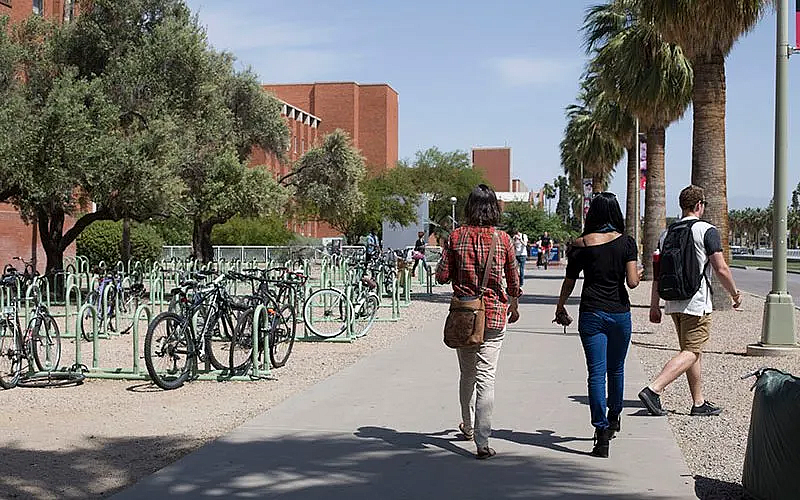
The enrollment data provided by the universities includes online-only programs. Latino enrollment increases excluding online programs were smaller, the data shows.
Colleges and universities where Latinos make up at least 25% of the undergraduate student population are eligible for additional federal funding as Hispanic Serving Institutions to provide support to low-income Latino students.
The University of Arizona achieved that designation in 2018. The university since has received more than $9 million in federal grants through a competitive process.
"What’s super important to mention here is that we have to competitively apply for these funds; they are not just given to us," Franco said in a follow-up email. "And there are close levels of accountability on how funds are used and for what purpose. HSIs do not receive any automatic funding.”
The influx of Latino students in 2020 during the pandemic boosted Latino enrollment to 28% of total undergraduate enrollment at the University of Arizona, an analysis of enrollment data shows.
The following year, Latino undergraduate enrollment fell to 27% of total undergraduate enrollment, the data shows.
The university has launched a number of initiatives aimed at continuing to increase Latino enrollment, from programs that providing mentoring students to programs that introduce students to resources to help them find a career after graduation, Franco said.
The fact that more than one in four undergraduate students at the university is now Latino is "definitely something to acknowledge and kind of celebrate," Franco said.
But, "it's not in parity with the representation that that population has in the state of Arizona," Franco said, "or the representation of Hispanic/Latino students within our school system in Arizona."
Latinos make up about a third of Arizona's population but they make a much higher share of the K-12 student population, 45%. Pima County, where the University of Arizona is, has a higher share of Latinos than the state as a whole: 38% of Pima County residents are Latino, according to census data.
"So we are still woefully underrepresented within our student enrollment, even though we've made considerable progress over the past couple of years," Franco said.
Estudiantes de ASU escuchan a los oradores durante una ceremonia virtual con fiestas de visualización en persona en el campus del centro de Phoenix el 3 de mayo de 2021. Nick Oza/The Republic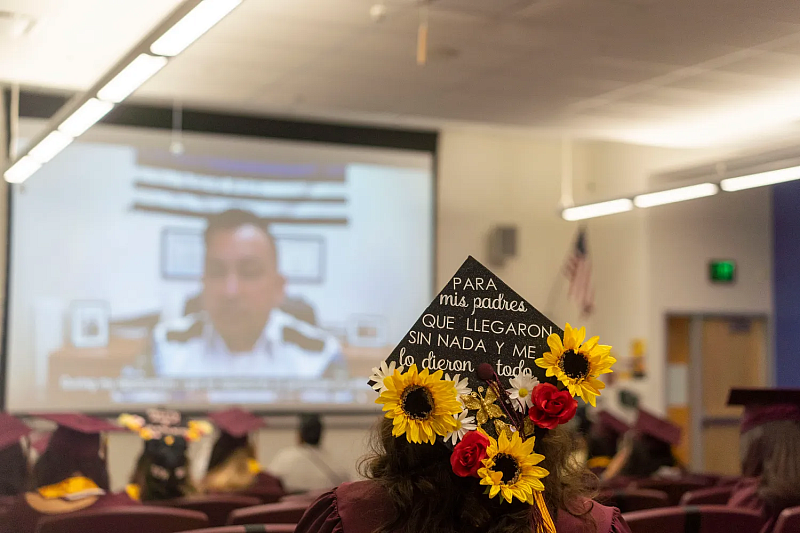
Online program helped ASU boost enrollment
Arizona State University has been trying to grow its Latino student enrollment, too.
It's a matter of "dollars and cents," said Matthew Lopez, ASU's associate vice president for academic enterprise enrollment and executive director of admission services.
Arizona needs more college educated workers to attract more companies and high-paying jobs. The state lags behind other states in college attainment and boosting Latino college enrollment is a key factor in boosting the college educated workforce, he said.
"The honest truth is we are not educating enough citizens of our state to continue to grow our economy, to continue to be a competitive state for industry to come and employ our citizens," Lopez said.
The honest truth is we are not educating enough citizens of our state to continue to grow our economy. -Matthew Lopez, ASU's associate vice president for academic enterprise enrollment and executive director of admission services
Enrollment data shows that the number of Latino undergraduate students enrolled at ASU increased during the pandemic. Latino undergraduate enrollment increased 7% in the fall of 2020 compared with the year before and 4% in the fall of 2021.
The increase in Latino undergraduate enrollment largely was driven by an overall increase in students enrolling in online programs during the pandemic, Lopez said. The university already had been investing in technology to expand its online programs prior to the pandemic. The expansion of online programs are part of efforts to increase overall enrollment.
"We are a university that's built upon (finding) every student that is admissible and (admitting) them to ASU and (giving) them the opportunity for an education," he said.
As a result, the university was well-positioned to accommodate an influx of students who preferred to enroll in online courses during the pandemic, he said.
Since 2012, Latino undergraduate enrollment at ASU has increased 128%, from 11,480 to 26,210 in 2021, an analysis of enrollment data shows.
Latinos now make 24% of the overall number of undergraduate students enrolled at ASU, up from 19% in 2012, the data shows
Un conductor se dirige al campus de la Universidad del Norte de Arizona en Flagstaff el 2 de octubre de 2019. Tom Tingle/The Republic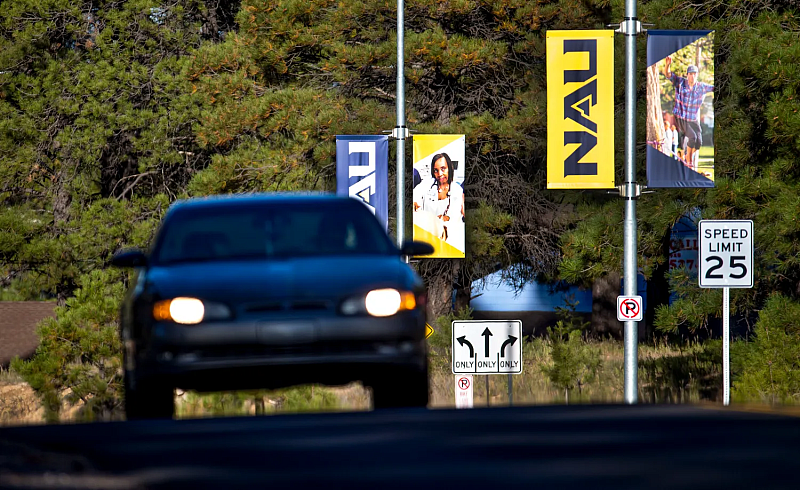
NAU reaches out to potential students after enrollment drop
At Northern Arizona University, officials launched a program during the pandemic to reach out to students who graduated from high school in 2020 and had shown interest in NAU, or had applied, but did not enroll.
NAU is the smallest of Arizona's three public universities. Latino undergraduate enrollment fell during the pandemic, by 5% in Fall 2020, and by another 2% in 2021, according to an analysis by The Arizona Republic of data provided by NAU.
The decreases in Latino undergraduate enrollment during the pandemic follow years of significant increases in Latino enrollment, the analysis shows.
Overall enrollment, however, at NAU has been on a downward trajectory for several years.
As a result, Latinos make up a larger share of the overall undergraduate enrollment at NAU, data shows. In 2021, Latinos made up 26% of the undergraduate student population, up from 18% in 2012.
In 2021, NAU met the federal government's requirements to be designated as a Hispanic Serving Institution.
During the pandemic, NAU launched a program to reach out to students who graduated from high school in 2020 and had shown interest in NAU but did not apply.
Before the outreach, the university checked to make sure the students had not already enrolled at any of the other Arizona public universities.
"If a student was interested in returning, we made that as seamless as possible, in that they didn’t need to fully reapply and we reoffered their original scholarship," officials said in a written statement.
César Soberanes, 19, estudiante de arte y ganador de la Beca Helios Adelante, posa para una fotografía en el balcón del Edificio de las Artes en Phoenix College en Phoenix, Arizona, el 7 de febrero de 2022. Megan Mendoza/The Republic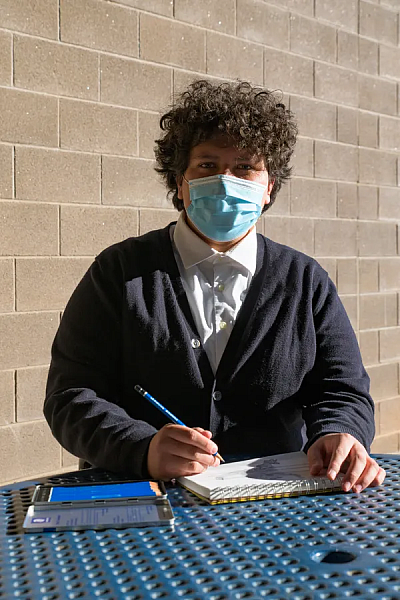
As for Soberanes, the student who had to withdraw from ASU because of the pandemic, he's taking classes at Phoenix College while working to earn money for tuition.
The year he missed gave him time to think about his future. He has decided he wants to major in arts education and become a ceramics teacher.
The federal Pell grants he received have covered the cost of tuition at Phoenix College.
The $1,000 scholarship he received from the Helios Education Foundation allowed him to pay for his textbooks. That way he didn't have to tap into the nest egg he's been building.
His plan now is to re-enroll at ASU in fall 2023 and graduate two years later, fulfilling the goal he made to himself and his family in 2020.
"I really want to be able to say I'm still doing it," he said.
Daniel Gonzalez reported this story while participating in the USC Annenberg Center for Health Journalism’s 2021 Data Fellowship, which provided training, mentoring, and funding to support this project.
Reach the reporter at daniel.gonzalez@arizonarepublic.com or at 602-444-8312. Follow him on Twitter @azdangonzalez. Support local journalism. Subscribe to azcentral.com today.
[This article was originally published by AZCentral.]

